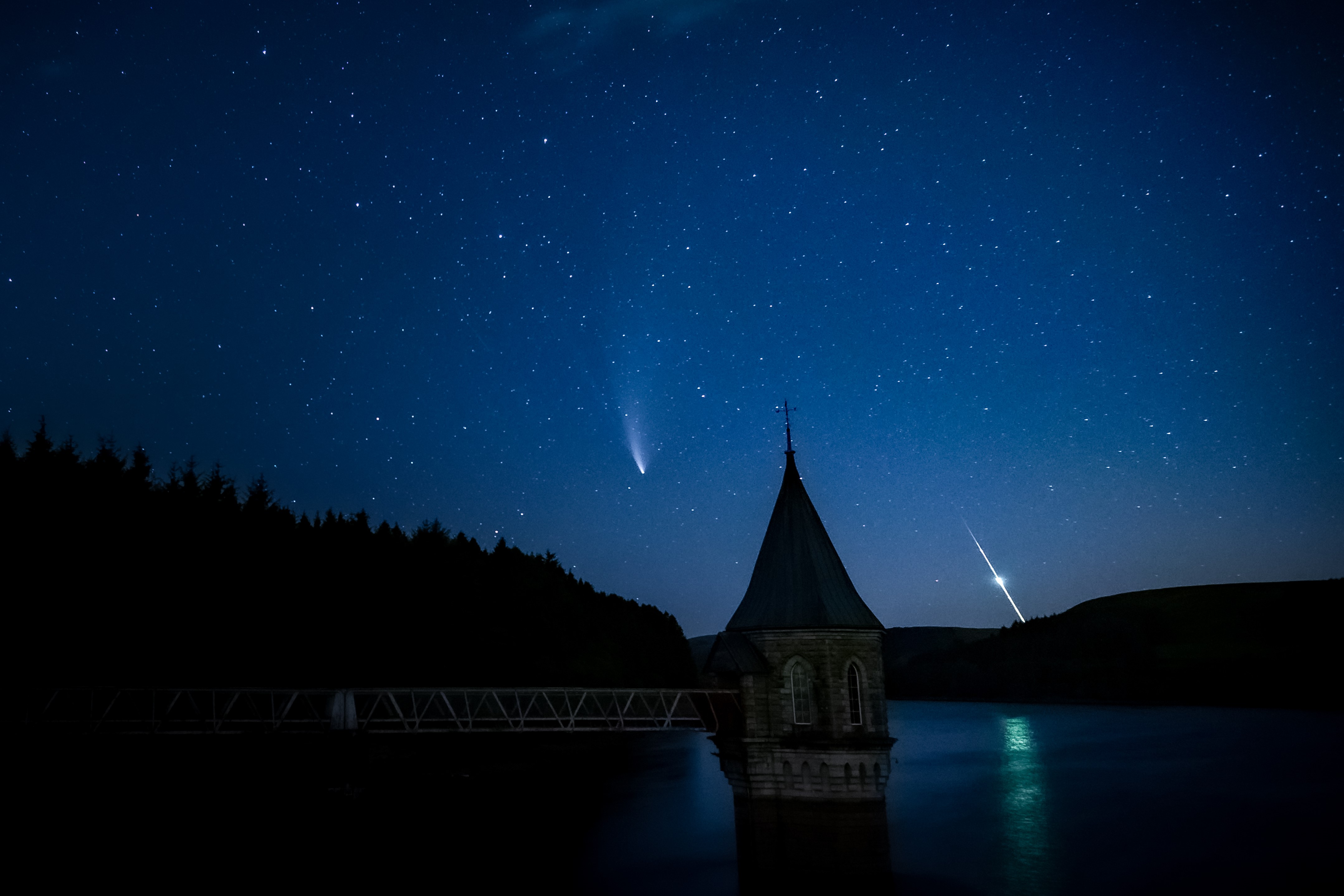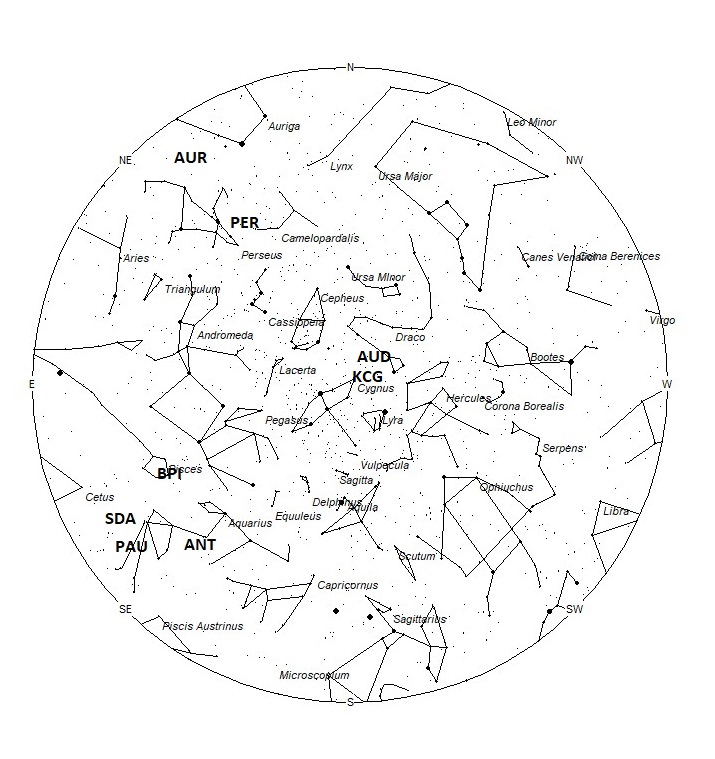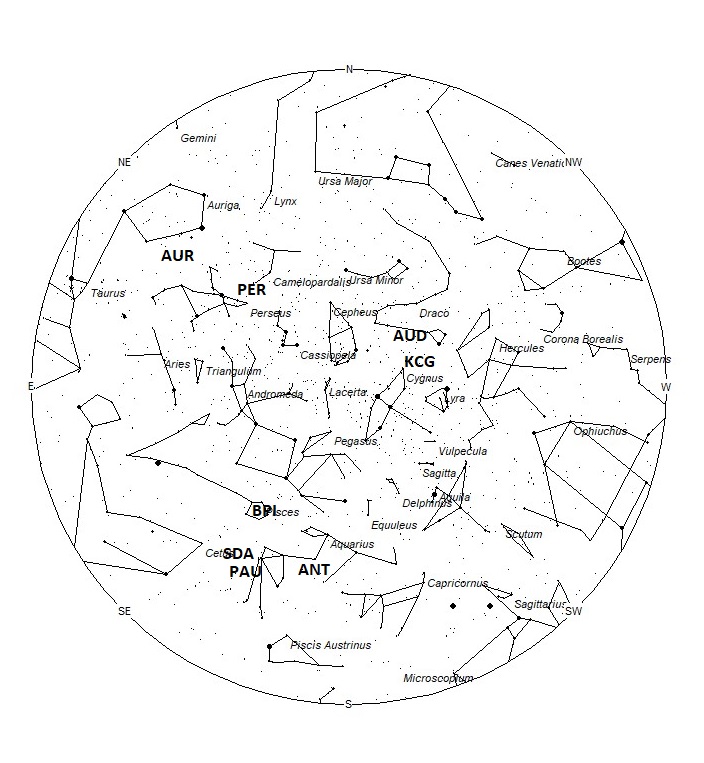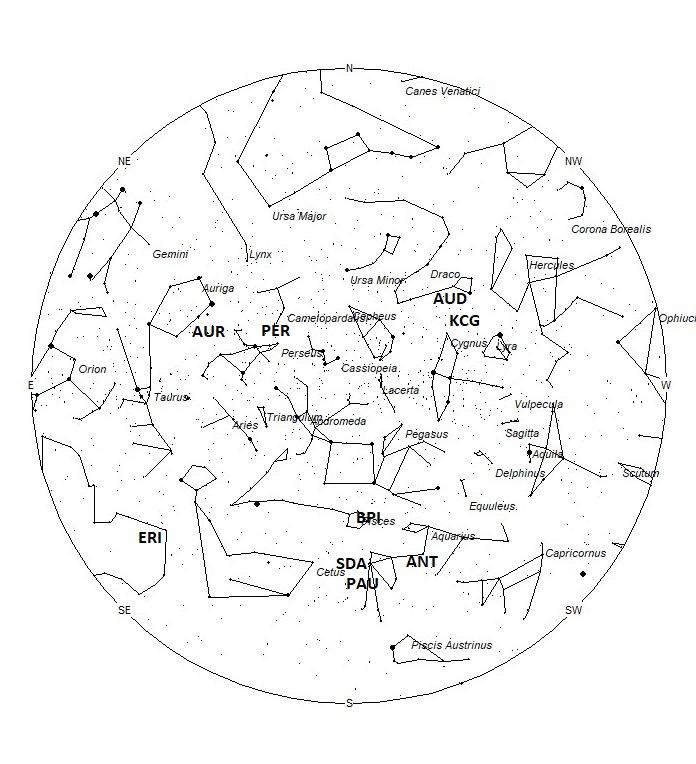
During this period, the moon reaches its new phase on Wednesday August 19th. At this time, the moon is located near the sun and is invisible at night. This weekend the waning crescent moon will rise during the early morning hours but will be too thin to interfere with meteor observing. The estimated total hourly meteor rates for evening observers this week is near 5 as seen from mid-northern latitudes and 4 as seen from tropical southern locations (25S). For morning observers, the estimated total hourly rates should be near 22 as seen from mid-northern latitudes (45N) and 13 as seen from tropical southern locations (25S). The actual rates will also depend on factors such as personal light and motion perception, local weather conditions, alertness, and experience in watching meteor activity. Note that the hourly rates listed below are estimates as viewed from dark sky sites away from urban light sources. Observers viewing from urban areas will see less activity as only the brighter meteors will be visible from such locations.
The radiant (the area of the sky where meteors appear to shoot from) positions and rates listed below are exact for Saturday night/Sunday morning August 15/16. These positions do not change greatly day to day so the listed coordinates may be used during this entire period. Most star atlases (available at science stores and planetariums) will provide maps with grid lines of the celestial coordinates so that you may find out exactly where these positions are located in the sky. A planisphere or computer planetarium program is also useful in showing the sky at any time of night on any date of the year. Activity from each radiant is best seen when it is positioned highest in the sky, either due north or south along the meridian, depending on your latitude. It must be remembered that meteor activity is rarely seen at the radiant position. Rather they shoot outwards from the radiant, so it is best to center your field of view so that the radiant lies at the edge and not the center. Viewing there will allow you to easily trace the path of each meteor back to the radiant (if it is a shower member) or in another direction if it is a sporadic. Meteor activity is not seen from radiants that are located far below the horizon. The positions below are listed in a west to east manner in order of right ascension (celestial longitude). The positions listed first are located further west therefore are accessible earlier in the night while those listed further down the list rise later in the night.
These sources of meteoric activity are expected to be active this week.
.
The August Draconids (AUD) were discovered by Zdenek Sekanina in his study of meteor streams using radio methods. This stream is active from August 13-19 with maximum activity occurring on the 15th. The radiant is currently located at 18:08 (272) +59, which places it in southern Draco, 3 degrees northeast of the 4th magnitude star known as Grumium (xi Draconis A). This radiant is best placed near 22:00 local summer time (LST), when it lies on the meridian and is located highest in the sky. With an entry velocity of 21 km/sec., the average August Draconid meteor would be of slow velocity. Rates this week are expected to be near 1 per hour as seen from the northern hemipshere and less than 1 as seen from south of the equator. Due to the high northern declination these meteors are difficult to observe from the southern hemisphere.
The kappa Cygnids (KCG) are active from a radiant located near 19:08 (287) +52. This area of the sky lies in on the Draco/Cygnus border, 3 degrees southwest of the 4th magnitude star known as kappa Cygni. This radiant is best laced near 2300 LST when it lies on the meridian and is located highest in the sky. With a high northern declination, these meteors are difficult to view from the southern hemisphere. Expected hourly rates this week are near 1 as seen from the northern hemisphere and less than 1 as seen from south of the equator. With an entry velocity of 21 km/sec., the average meteor from this source would be of slow velocity.
The center of the large Anthelion (ANT) radiant is currently located at 22:24 (336) -10. This position lies in central Aquarius, 3 degrees southeast of the 4th magnitude star known as Ancha (theta Aquarii). Due to the large size of this radiant, anthelion activity may also appear from eastern Capricornus as well as central Aquarius. This radiant is best placed near 0200 LST, when it lies on the meridian and is located highest in the sky. Rates at this time should be near 1 per hour as seen from mid-northern latitudes (45 N) and 2 per hour as seen from the southern tropics (S 25). With an entry velocity of 30 km/sec., the average anthelion meteor would be of slow velocity.
The August beta Piscids (BPI) are synonymous with the northern delta Aquariids (NDA). Although the BPI’s have been removed from the IAU’s shower list, it best represents the classical activity of the NDA’s, first mentioned by Luigi G. Jacchia in his book The Moon, Meteorites and Comets. The peak, on August 13th, also occurs with the radiant within the borders of the constellation of Pisces. The radiant currently is located near 23:16 (349) +03. This area of the sky is located near the spot occupied by the 4th magnitude star known as gamma Piscium. This radiant is best placed near 0300 LST, when it lies on the meridian and is located highest in the sky. Hourly rates at this time should be near 1 no matter your location. With an entry velocity of 38 km/sec., the average meteor from this source would be of medium-slow velocity.
The radiant of the Southern Delta Aquariids (SDA) is now located at 23:46 (357) -10. This position is located in eastern Aquarius, 5 degrees north of the 4th magnitude star known as omega2 Aquarii. This radiant is best placed near 0300 LST, when it lies on the meridian and is located highest in the sky. Rates are expected to be less than 1 per hour this as seen from the northern hemisphere and near 1 per hour as seen from south of the equator. With an entry velocity of 41 km/sec., most activity from this radiant would be of average velocities.
The Piscids Austrinids (PAU) are an obscure shower, not well seen from the northern hemisphere. Recent studies by the IMO Video Network shows little activity. Other studies have indicated that this shower is active later than previously thought. We will go along with that idea until more information is available. It is now thought that this radiant is active from July 30 through August 18, with maximum activity occurring on the 8th. Using these parameters, the current position of the radiant would be 00:00 (000) -17. This area of the sky is located in southwestern Cetus, 4 degrees southwest of 4th magnitude star known as omega2 Aquarii. The radiant is best placed near 03:00 LST, when it lies highest in the sky. Current hourly rates should be less than 1 no matter your location. With an entry velocity of 44km/sec., most activity from this radiant would be of average velocities.
There is a slight possibility of activity from the beta Hydrusids (BHY) near 14:18 UT on August 16th. The far southern radiant is located at 02:25 (036) -75. This position lies just southwest of the small Magellanic Cloud or 5 degrees northwest of the 3rd magnitude star known as beta Hydri. This position is best placed near 05:00 LST, when it lies highest above the horizon. These visibility of these meteors are pretty much limited to the southern hemisphere as the radiant only lies 15 degrees from the southern celestial pole. With an entry velocity of 23km/sec., most activity from this radiant would be of slow velocities.
The eta Eridanids (ERI) are active from a radiant located near 03:14 (048) -11. This position lies in western Eridanus, 4 degrees southeast of the 4th magnitude star known as Azha (eta Eridani). This source is active until September 16th, with maximum activity having occurred on August 10th. Current rates are expected to be near 1 per hour no matter your location. These meteors are best seen during the last dark hour prior to dawn when the radiant lies highest above the horizon in a dark sky. With an entry velocity of 65 km/sec., the average meteor from this source would be of swift speed.
The Perseids (PER) are still active from a radiant located at 03:30 (052) +58. This position lies in western Camelopardalis, 8 degrees north of the 2nd magnitude star known as Mirfak (alpha Persei). This area of the sky is best placed for viewing during the last dark hour before dawn when it lies highest in the sky. Rates just prior to dawn are expected to be near 5 per hour as seen from the northern hemisphere and 2 per hour as seen from south of the equator. With an entry velocity of 59 km/sec., the average meteor from this source would be of swift velocity.
The first of the Aurigids (AUR) are expected this week from a radiant located at 04:44 (071) +39. This position lies in eastern Perseus, 2 degrees south of the faint star known as 58 Persei. This area of the sky is best seen during the last dark hour before dawn when the radiant lies highest in a dark sky. Current rates are expected to be less than 1 per hour no matter your location. Maximum activity is not expected until August 31st. With an entry velocity of 67 km/sec., the average meteor from this source would be of swift velocity.
Morning sporadic rates are expected to be near 12 per hour as seen from mid-northern latitudes and 6 as seen from tropical southern latitudes. Evening rates should be near 4 as seen from the northern hemisphere and 3 as seen from tropical southern latitudes. Morning rates are reduced due to interfering moonlight.
The list below offers the information from above in tabular form. Rates and positions are exact for Saturday night/Sunday morning except where noted in the shower descriptions.
| SHOWER | DATE OF MAXIMUM ACTIVITY | CELESTIAL POSITION | ENTRY VELOCITY | CULMINATION | HOURLY RATE | CLASS |
| RA (RA in Deg.) DEC | Km/Sec | Local Summer Time | North-South | |||
| August Draconids (AUD) | Aug 15 | 18:08 (272) +59 | 21 | 22:00 | 1 – <1 | IV |
| kappa Cygnids (KCG) | Aug 13 | 19:08 (287) +52 | 21 | 23:00 | 1 – <1 | IV |
| Anthelion (ANT) | – | 22:24 (336) -10 | 30 | 02:00 | 1 – 2 | II |
| August beta Piscids (BPI) | Aug 13 | 23:16 (349) +03 | 41 | 03:00 | <1 – <1 | IV |
| South delta Aquariids (SDA) | Jul 29 | 23:46 (357) -10 | 41 | 03:00 | <1 – 1 | I |
| Piscids Austrinids (PAU) | Aug 08 | 00:00 (000) -17 | 44 | 03:00 | <1 – <1 | II |
| beta Hydrusids (BHY) | Aug 16 | 02:25 (036) -75 | 23 | 05:00 | <1 – <1 | III |
| eta Eridanids (ERI) | Aug 10 | 03:14 (048) -11 | 65 | 06:00 | 1 – 1 | IV |
| Perseids (PER) | Aug 12 | 03:30 (052) +58 | 59 | 06:00 | 5 – 2 | I |
| Aurigids (AUR) | Aug 31 | 04:44 (071) +39 | 67 | 07:00 | <1 – <1 | II |







 You saw something bright and fast? Like a huge shooting star? Report it: it may be a fireball.
You saw something bright and fast? Like a huge shooting star? Report it: it may be a fireball.  You counted meteors last night? Share your results with us!
You counted meteors last night? Share your results with us!  You took a photo of a meteor or fireball? You have a screenshot of your cam? Share it with us!
You took a photo of a meteor or fireball? You have a screenshot of your cam? Share it with us!  You caught a meteor or fireball on video? Share your video with us!
You caught a meteor or fireball on video? Share your video with us!